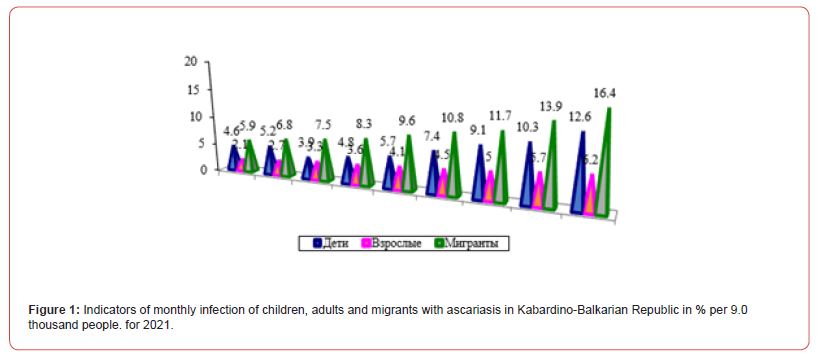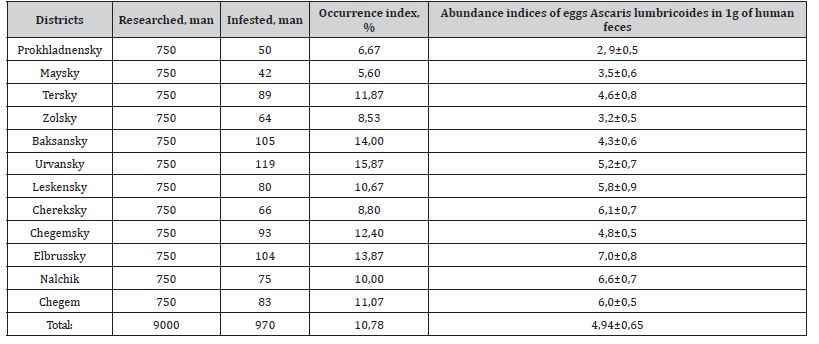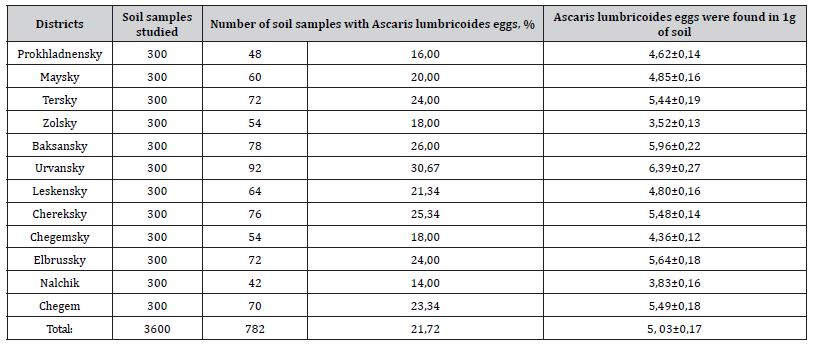 Mini Review
Mini Review
Bone Disease, Different Pathogenesis and Treatment
Bittirov IA1, Gazaeva AA2 and Bittirov AM3*
1Kabardino-Balkarian State Agrarian University, Russia
2Gazaeva Asiyat Anatolyevna, Kabardino-Balkarian State Agrarian University, Russia
3Anatoly Murashevich Bittirov, Doctor of Biological Sciences, of Veterinary Medicine, Kabardino-Balkarian State Agrarian University, Russia
State Budgetary Educational Institution of Higher Education “Kabardino-Balkarian State Agrarian University, Nalchik, Russia.
Received Date: February 27, 2023; Published Date: March 24, 2023
Abstract
The goal is to monitor human ascariasis as an epidemic and sanitary and hygienic threat to the population of the southern subject of the Russian Federation. When analyzing materials on the incidence of ascariasis in the population of Karachay-Cherkessia, it showed that in 10 districts and 2 cities the index of occurrence of ascariasis in the population varied from 5.60 to 15.87%. The gradation of the abundance index of eggs Ascaris lumbricoides in human feces ranged from 2.90.5 to 7.00.8 ind. per 1 g of feces, on average 4.940.65 ind., which can provide a high level of soil contamination with eggs. In general, the epidemic situation of ascariasis in the subject can be attributed to relatively favorable. In the region, the incidence of people with ascariasis is low due to the planned anti-epidemic work. At the same time, the subject can be attributed to risk regions, since the number of sick children, adults and migrants does not tend to decrease, but there is an increase in invasion during the year. The growth of the index of occurrence of ascariasis among children and migrants is alarming. Indices of ascariasis occurrence in the child population and migrants increases during the year by 2.78 times. Soils in 10 districts and 2 cities are contaminated with eggs of Ascaris lumbricoides by 14.00-30.67% (average, 21.72%), which may threaten the possible infection of the population with ascariasis.
Keywords: Kabardino-Balkarian Republic; Human; Monitoring; Ascariasis; Egg; Soil; Invasion; Occurrence index; Abundance index
Introduction
Many authors consider helminthiases of animals and humans to be a large-scale sanitary threat to the urbanized territories of Russia, the eggs and larvae of which are contaminated soils and wastewater [1-20]. Nematodes of the species Ascaris lumbricoides (Linnaeus, 1758) are one of the global epidemic risks for the population of the planet and the Russian Federation [1,2]. WHO considers that human ascariasis is one of the massive zoonotic invasions in the world with a registration rate of up to 1.2 billion cases per year [1- 13]. In the Russian Federation, ascariasis affects up to 3-3.5 million people and exceeds similar indicators in European countries by 3 times [14-20]. In this regard, the question arises of regional monitoring of the spread of ascariasis among the population and the degree of sanitary contamination of soils of human life support infrastructure with eggs of the pathogen [1-20]. The aim is to study the nematodes Ascaris lumbricoides as an epidemic and sanitary and hygienic threat to humans in the southern region of the Russian Federation.
Materials and methods
Based on the analysis of materials from the reports of the structural divisions of the Rospotrebnadzor of the Russian Federation for Kabardino-Balkarian Republic for 2021 and other medical documentation and our own research, we calculated the incidence of ascariasis in 10 districts and 2 cities of Kabardino- Balkarian Republic and sanitary contamination of soils with eggs of the species Ascaris lumbricoides. The main epidemiological indicators of ascariasis in the population of Kabardino-Balkarian were studied by analyzing feces for 9.0 thousand people. and 3600 soil samples for sanitary contamination with eggs Ascaris lumbricoides. Statistical processing of the material was carried out using the Biometrics program.
Results and Discussion
When analyzing materials on the incidence of ascariasis in the population of Kabardino-Balkarian Republic, it showed that in 10 districts and 2 cities, the index of occurrence of ascariasis in children and adults varied from 5.60 to 15.87% (table 1). The gradation of the abundance index of Ascaris lumbricoides eggs in human feces ranged from 2.9±0.5 to 7.0±0.8 ind. in 1 g of feces, on average 4.94±0.65 ind. per 1 g of feces, which can provide a high level of soil contamination with eggs (Table 1). In general, in the Kabardino-Balkarian Republic, the epidemic situation in human ascariasis can be classified as relatively favorable (Figure 1) (Table 1).

Table 1: The results of the analysis of the data of the Kabardino-Balkarian Republic SES on the incidence of ascariasis (Ascaris lumbricoides) in the regions of Kabardino-Balkarian Republic (% per 10.0 thousand population).

In Kabardino-Balkarian Republic, the incidence of people with ascariasis is low due to the planned anti-epidemic work (Rice. 1). At the same time, Kabardino-Balkarian can be attributed to risk regions, since the number of children, adults and migrants with ascariasis does not tend to decrease, but there is an increase in invasion during the year (Rice.1). The growth of the index of occurrence of ascariasis among children and migrants is alarming. Indices of ascariasis occurrence in the child population and migrants increased during the year by 2.8 times (Figure 1).
Soils of 12 districts and cities of the Kabardino-Balkarian Republic were also analysed for contamination with eggs of the ascariasis pathogen (Ascaris lumbricoides), the results of which are presented in Table 2. As can be seen, the soils of 12 districts and cities of the Kabardino-Balkarian Republic are contaminated by 14.00-30.67% (average, 21.72%) with eggs of the nematode Ascaris lumbricoides, which can be a factor in infecting people with ascariasis (Table 2).
Table 2: Results of monitoring the sanitary contamination of soils in settlements of the Kabardino-Balkarian Republic with eggs of the causative agent of ascariasis (Ascaris lumbricoides) (in absolute numbers and in %).

Conclusion
When analyzing materials on the incidence of ascariasis in the population of Kabardino-Balkarian Republic, it showed that in 10 districts and 2 cities the index of occurrence of ascariasis in the population varied from 5.60 to 15.87%. The gradation of the abundance index of Ascaris lumbricoides eggs in human feces ranged from 2.9±0.5 to 7.0±0.8 ind. per 1 g of feces, on average 4.94±0.65 ind., which can provide a high level of soil contamination with eggs. In general, the epidemic situation of ascariasis in the subject can be attributed to relatively favorable. In the region, the incidence of people with ascariasis is low due to the planned antiepidemic work. At the same time, the subject can be attributed to risk regions, since the number of sick children, adults and migrants does not tend to decrease, but there is an increase in invasion during the year. The growth of the index of occurrence of ascariasis among children and migrants is alarming. Indices of ascariasis occurrence in the child population and migrants increases during the year by 2.8 times. Soils in 10 districts and 2 cities are contaminated with eggs of Ascaris lumbricoides by 14.00-30.67% (average, 21.72%), which may threaten the possible infection of the population with ascariasis.
Acknowledgement
None.
Conflicts of Interest
No Conflicts of Interest.
References
- Melton J (1993) Hip fracture; a worldwide problem today and tomorrow. Bone 14: S1-8.
- Silva DMW (2018) Diagnosis of osteoporosis; bone mineral density, risk factors, or both. EC Orthopaedics 9(7): 500-502.
- Choudhary D, Alam A (2018) Anti-osteoporotic activity of bioactive compounds from Iris germanica targeting NK-Kappa B. EC Pharmacology & Toxicology 6 (8): 665-678
- Lu DY, Shen Y (2020) Bone surgery, tissue and function repairs. EC Orthopaedics 11(3): 1-2
- Lu DY, Che JY, Putta S, Wu HY, Shen Y (2019) How to improve the quality of pharmacotherapy for bone diseases. EC Orthopeadicis 10 (6): 366-369
- Lu DY, Che JY, Shen Y (2018) Osteoporosis, importance for early diagnosis and treatment. EC Orthopaedics 9 (9): 624-625
- Lu DY, Che JY, Shen Y (2018) Clinical treatments of osteoporosis, how to target co-morbidities. EC Orthopaedics 9(11): 781-782
- Negm SH (2018) The possible protective role of powder cuttlefish bone, crab shell and eggshell on osteoporotic rats. J Food and Diary Science 9(10): 111-121
- Lu DY, Che JY, Yarla NS, Putta S, Shen Y (2019) Bone disease recovery strategies, An overview. EC Orthopaedics 10 (1): 1-3
- Moore N, Slater GL (2019) Surgical technique update: Slater modification of minimally invasive brostrom reconstruction. EC Orthopaedics 10 (5): 308-314
- Araujo JL (2018) The role of the orthopedic surgeon in preventing low back pain chronification. EC Orthopaedics 9(12): 809-812
- Harsini SM, Oryan A (2018) Bone grafting and the materials for using in orthopaedics. EC Orthopaedics 9(12): 822-833
- Lu DY, Lu TR, Putta S, Shen Y (2019) Bone disease treatments, math-therapeutic modality. EC Orthopaedics. 10 (3): 140-143
- Zweedijk R, Tylleman C, Schwind P (2020) Scoliosis and osteopathy. Acta Scientific Orthopaedics 3(9): 30-43
- Koleva IB, Yoshinov B (2020) Rehabilitation as an essential element in the clinical practice of orthopaedics and traumatology. Acta Scientific Orthopaedics 3(9): 44-46
- Ban J, Fock V, Aryee DN, Kovar H (2021) Mechanisms, diagnosis and treatment of bone metastases. Cells 10(11): 2944.
- Lu DY, Xu B (2021) Cancer bone metastasis, experimental study. Acta Scientific Orthopaedics 5(12): 1-3: 10.
- Leung PC (2014) Traditional Chinese medicine in orthopaedics-problems and future direction. Open J Therapy Rehibilitations 2 (1): 1-4.
- Che JY, Lu DY (2021) Acupuncture for bone disease treatment. EC Orthopaedics 12(1): 15-16
- Lu DY, Chen YZ, Lu DF, Che JY (2019) Patients care and nursery in different diseases. Hospice and Palliative Medicine International Journal 3(1): 28-30.
-
Bittirov IA, Gazaeva AA and Bittirov AM*. Monitoring of human ascariasis as a threat to public health and habitat in the southern regions of the Russian Federation. Arch Biomed Eng & Biotechnol. 7(2): 2022. ABEB.MS.ID.000658.
-
Kabardino-Balkarian Republic, Human, Monitoring, Ascariasis, Egg, Soil, Invasion, Occurrence index, Abundance index
-

This work is licensed under a Creative Commons Attribution-NonCommercial 4.0 International License.






